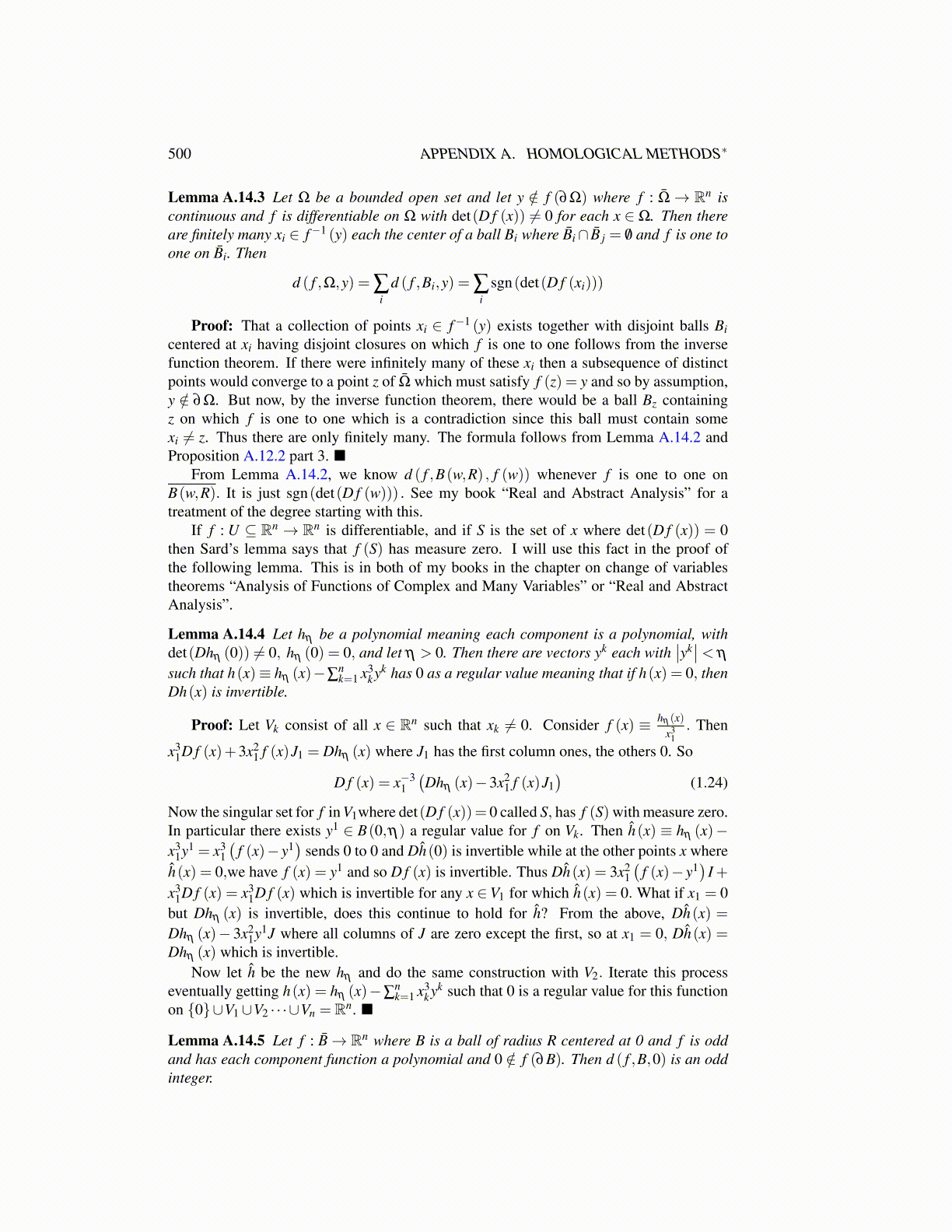
500 APPENDIX A. HOMOLOGICAL METHODS∗
Lemma A.14.3 Let Ω be a bounded open set and let y /∈ f (∂Ω) where f : Ω̄→ Rn iscontinuous and f is differentiable on Ω with det(D f (x)) ̸= 0 for each x ∈ Ω. Then thereare finitely many xi ∈ f−1 (y) each the center of a ball Bi where B̄i∩ B̄ j = /0 and f is one toone on B̄i. Then
d ( f ,Ω,y) = ∑i
d ( f ,Bi,y) = ∑i
sgn(det(D f (xi)))
Proof: That a collection of points xi ∈ f−1 (y) exists together with disjoint balls Bicentered at xi having disjoint closures on which f is one to one follows from the inversefunction theorem. If there were infinitely many of these xi then a subsequence of distinctpoints would converge to a point z of Ω̄ which must satisfy f (z) = y and so by assumption,y /∈ ∂Ω. But now, by the inverse function theorem, there would be a ball Bz containingz on which f is one to one which is a contradiction since this ball must contain somexi ̸= z. Thus there are only finitely many. The formula follows from Lemma A.14.2 andProposition A.12.2 part 3. ■
From Lemma A.14.2, we know d ( f ,B(w,R) , f (w)) whenever f is one to one onB(w,R). It is just sgn(det(D f (w))) . See my book “Real and Abstract Analysis” for atreatment of the degree starting with this.
If f : U ⊆ Rn → Rn is differentiable, and if S is the set of x where det(D f (x)) = 0then Sard’s lemma says that f (S) has measure zero. I will use this fact in the proof ofthe following lemma. This is in both of my books in the chapter on change of variablestheorems “Analysis of Functions of Complex and Many Variables” or “Real and AbstractAnalysis”.
Lemma A.14.4 Let hη be a polynomial meaning each component is a polynomial, withdet(Dhη (0)) ̸= 0, hη (0) = 0, and let η > 0. Then there are vectors yk each with
∣∣yk∣∣< η
such that h(x)≡ hη (x)−∑nk=1 x3
kyk has 0 as a regular value meaning that if h(x) = 0, thenDh(x) is invertible.
Proof: Let Vk consist of all x ∈ Rn such that xk ̸= 0. Consider f (x) ≡ hη (x)x3
1. Then
x31D f (x)+3x2
1 f (x)J1 = Dhη (x) where J1 has the first column ones, the others 0. So
D f (x) = x−31(Dhη (x)−3x2
1 f (x)J1)
(1.24)
Now the singular set for f in V1where det(D f (x))= 0 called S, has f (S) with measure zero.In particular there exists y1 ∈ B(0,η) a regular value for f on Vk. Then ĥ(x) ≡ hη (x)−x3
1y1 = x31(
f (x)− y1)
sends 0 to 0 and Dĥ(0) is invertible while at the other points x whereĥ(x) = 0,we have f (x) = y1 and so D f (x) is invertible. Thus Dĥ(x) = 3x2
1(
f (x)− y1)
I+x3
1D f (x) = x31D f (x) which is invertible for any x ∈V1 for which ĥ(x) = 0. What if x1 = 0
but Dhη (x) is invertible, does this continue to hold for ĥ? From the above, Dĥ(x) =Dhη (x)− 3x2
1y1J where all columns of J are zero except the first, so at x1 = 0, Dĥ(x) =Dhη (x) which is invertible.
Now let ĥ be the new hη and do the same construction with V2. Iterate this processeventually getting h(x) = hη (x)−∑
nk=1 x3
kyk such that 0 is a regular value for this functionon {0}∪V1∪V2 · · ·∪Vn = Rn. ■
Lemma A.14.5 Let f : B̄→ Rn where B is a ball of radius R centered at 0 and f is oddand has each component function a polynomial and 0 /∈ f (∂B). Then d ( f ,B,0) is an oddinteger.